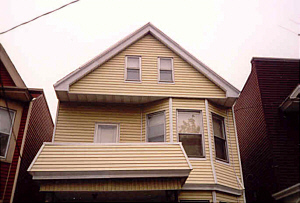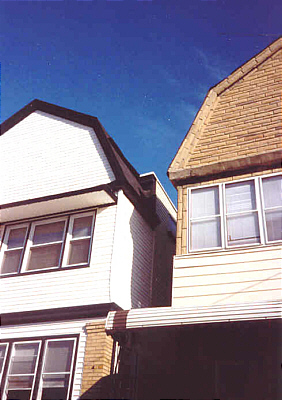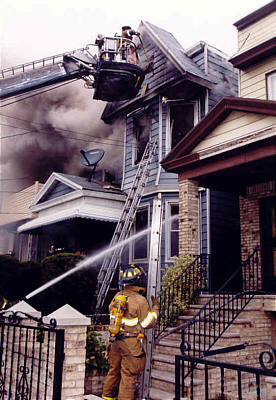Articles
Menu
- Promotional Assessment Centers, Understanding the process
- Lifeline Search: A Systematic Approach
- SCBA Basics
- Yankee Gutters: The Hidden Danger
- Tools For Managing The Incident
- Roof Operations: Listen, Look and Cut
- False Peaks: Help or Hindrance to Firefighting Operations?
- Water Supply: The Operating And Supply Pumper Concept
- The Jersey City Effort
- Size-Up: Updating An Old Acronym
- Jersey City Waterfront Triage
- Fireground Size-Up For Factory and Warehouse Fires
- Fireground Size-Up: Row Frames
- Fireground Size-Up For Garden Apartments And Townhouses
False Peaks: Help or Hindrance to Firefighting Operations?
“Hollywood front” is a term that causes great  concern for many firefighters who respond and operate at private dwelling fires. In many parts of the country, firefighters are required to deal with this unique architectural design almost on a daily basis. When identified and factored into the firefighter’s and fire officer’s decision-making, they can eliminate a danger, as well as possibly aid in the overall operation.
concern for many firefighters who respond and operate at private dwelling fires. In many parts of the country, firefighters are required to deal with this unique architectural design almost on a daily basis. When identified and factored into the firefighter’s and fire officer’s decision-making, they can eliminate a danger, as well as possibly aid in the overall operation.
 The “Hollywood front” got its name from the practice of the motion-picture industry of the West Coast. In order to create the look of an actual building without totally erecting one, set designers would create a facade or front of a building to give the viewer the appearance of an actual building. This facade was often nothing more than the front shell of a building with all the windows, trim, paint, and curtains in place to give the illusion of an actual structure. If someone were able to view the rear of this wall, all they would see is structural bracing holding a building facade in place.
The “Hollywood front” got its name from the practice of the motion-picture industry of the West Coast. In order to create the look of an actual building without totally erecting one, set designers would create a facade or front of a building to give the viewer the appearance of an actual building. This facade was often nothing more than the front shell of a building with all the windows, trim, paint, and curtains in place to give the illusion of an actual structure. If someone were able to view the rear of this wall, all they would see is structural bracing holding a building facade in place.
Identification and Concern
In the real world, Hollywood front buildings, although a little better constructed, are a common sight in many areas of the country today. Where the fire service seems to be finding this architectural design is on two or three-story flat-roof buildings. Originally constructed as a flat roof building, a false peak, or as it is referred to in this article, Hollywood front, is erected to give the illusion from the street of a peaked roof building. This addition to the actual roofline was done for esthetics purposes as well as to give the look of a much larger square footage building.
The key to a Hollywood front’s identification is district or area familiarization. Officers should know well before an incident occurs if and where any of these false peaks exist.
In addition to your pre-incident information, building size-up is a must. With many of these designs, your on-scene identification starts by viewing the building from the side, corner, or rear. It is here, in many cases, where you will actually be able to see a two-story, flat-roof building where the false peak starts. Once identified, you will notice that the false peak itself can extend above the flat roof deck between eight to 12 feet and could extend back from the front of the building as much as six to eight feet.
 One of the first concerns of the Hollywood front we identified in Jersey City was the probability of laddering the peak from the street side at night or during difficult weather conditions. If the false peak was not identified, an unsuspecting firefighter may think he/she is climbing onto a peaked roof only to crawl a few steps and drop eight to twelve feet to the actual roof deck below.
One of the first concerns of the Hollywood front we identified in Jersey City was the probability of laddering the peak from the street side at night or during difficult weather conditions. If the false peak was not identified, an unsuspecting firefighter may think he/she is climbing onto a peaked roof only to crawl a few steps and drop eight to twelve feet to the actual roof deck below.
Another illusion created by a Hollywood front that may add to the firefighters confusion is that some false peaks may actually have a window or windows, which may give the appearance of an attic apartment. Although the depth of a Hollywood front may vary, if there is any accessibility from the building’s interior, the space is most likely used for storage. But never rule out the possibility of a bedroom, especially if the depth of the Hollywood front is in excess of eight feet. I have personally seen some creative designs with curtains and blinds installed which can further confuse those as they view the building from the street. When in doubt, check!
 Hollywood fronts further emphasize the need for firefighters to attempt to view more than just the street side of the building as they arrive on the scene. At times when the building is closely spaced by other buildings, there may be difficulty viewing the entire peak. The depth of the false peak may exclude your ability to identifying its presence from the front of the building. A visual cue that we quickly picked up on is viewing the building’s corner where the peaked slope meets the roofline. It is here where you will see a small section of the building’s true roof line tipping members off to a flat-roofed, not a peaked- roof, building.
Hollywood fronts further emphasize the need for firefighters to attempt to view more than just the street side of the building as they arrive on the scene. At times when the building is closely spaced by other buildings, there may be difficulty viewing the entire peak. The depth of the false peak may exclude your ability to identifying its presence from the front of the building. A visual cue that we quickly picked up on is viewing the building’s corner where the peaked slope meets the roofline. It is here where you will see a small section of the building’s true roof line tipping members off to a flat-roofed, not a peaked- roof, building.
Access options
One of the few positives with the Hollywood front that can aid the fire department in its efforts is the area of the peak that encompasses the windows or vent. Depending upon when it was installed and how the area accessed the original construction, removal of the windows or vent may give direct access to the buildings cockloft/attic space. By placing a tower ladder or aerial ladder up to the gable end, and then removing, as well as enlarging the opening, accessibility into the space may aid in the ventilation of the cockloft area, or depending upon conditions, the operation of a stream into the space.
